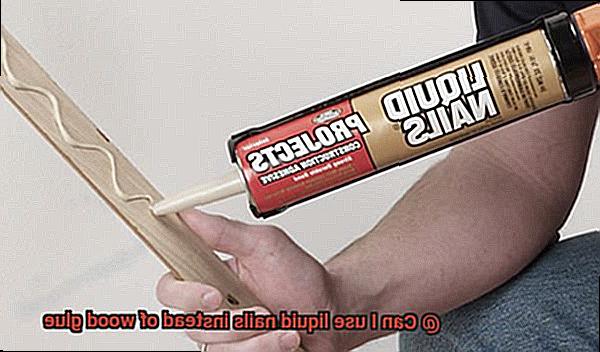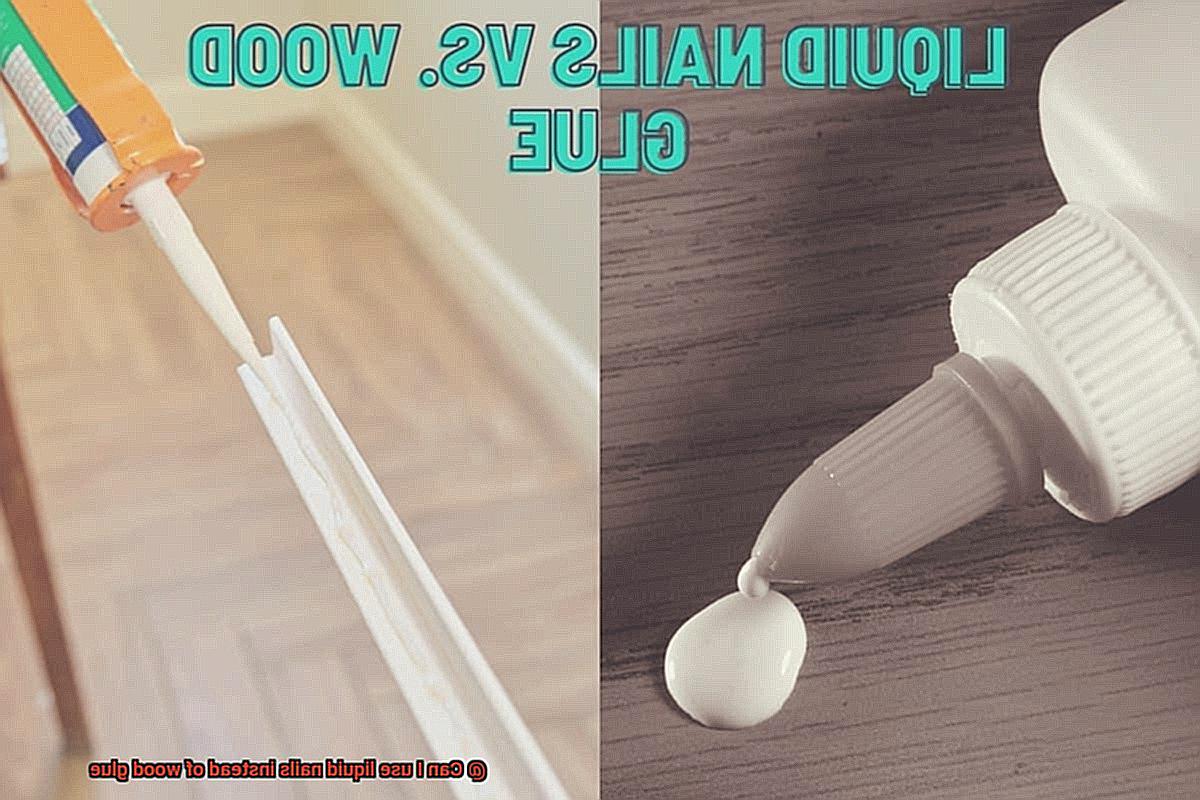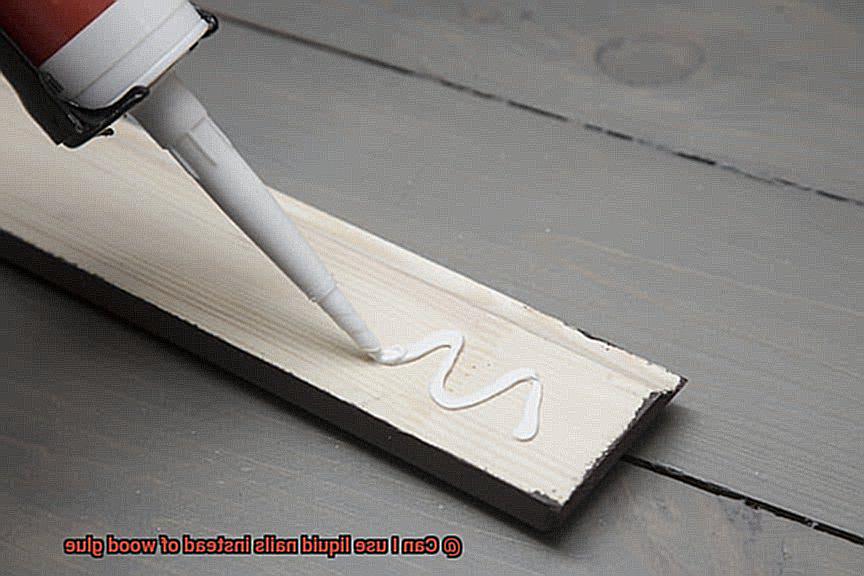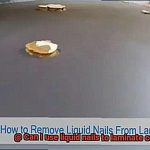Are you a DIY pro or just starting out in the world of woodworking? If so, you know that having the right adhesive is key to getting those wooden projects to stick together. Two popular choices often come up: liquid nails and wood glue. But can you swap one for the other? In this blog post, we’ll dive into the pros and cons of using liquid nails instead of traditional wood glue.
Let’s talk money. Wood glue won’t break the bank, with its affordable price tag making it a go-to for many budget-conscious builders. On the flip side, liquid nails might cost you a tad more, but if you want extra strength and durability, it could be worth shelling out a few extra bucks.
Now let’s get down to application methods. Wood glue comes in handy squeeze bottles or applicators, making it easy to use with precision and minimal mess. Liquid nails, on the other hand, come in tubes that require a caulk gun for proper dispensing. It may take some practice to get the hang of it, but once you do, applying liquid nails becomes a breeze – especially when reaching those tricky corners.
One major advantage of liquid nails over wood glue is their versatility. While wood glue sticks mainly to wood (no surprise there), liquid nails can bond various materials like metal, concrete, and ceramics too. So if your project involves different surfaces, using liquid nails could save you from buying multiple adhesives.
But hold on; there are some things to consider before swapping out wood glue for liquid nails. Ventilation is crucial because liquid nails release fumes during drying that may not be good for your health. Plus, they take longer to dry and form a solid bond compared to wood glue. If time is tight on your project timeline, sticking with wood glue might be your best bet.
In the end, choosing between liquid nails and wood glue depends on your project’s specific needs. Cost, application methods, and materials all come into play. By understanding the pros and cons of each adhesive, you can make an informed decision and ensure your woodworking projects stick together like a dream. Keep an eye out for our upcoming posts, where we’ll delve deeper into the intricacies of each adhesive and share valuable tips for their application.
What is Liquid Nails?
Contents
- 1 What is Liquid Nails?
- 2 What is Wood Glue?
- 3 Differences between Liquid Nails and Wood Glue
- 4 Drying Time of Liquid Nails vs Wood Glue
- 5 Flexibility of Adhesive
- 6 Choosing the Right Adhesive for Your Project
- 7 Can I Use Liquid Nails Instead of Wood Glue?
- 8 Alternatives to Traditional Wood Glue
- 9 Conclusion
Liquid Nails: The Ultimate Bonding Solution for Your Construction Projects
When it comes to construction and DIY projects, having the right adhesive is crucial. And one adhesive that shines in the industry is Liquid Nails. This remarkable adhesive is celebrated for its extraordinary bonding properties and unwavering durability, making it the go-to choice for professionals and homeowners alike.
But what exactly is Liquid Nails? In essence, it is a brand of construction adhesive that possesses the remarkable ability to bond different materials together. Whether you’re working with wood, metal, concrete, or more, Liquid Nails has got your back. Its versatility is truly unparalleled.
Liquid Nails comes in a dazzling array of formulations designed to cater to different applications. Need a heavy-duty adhesive for a demanding project? Liquid Nails has you covered. Craving a fast-drying solution for those quick turnarounds? Look no further than Liquid Nails. What’s more, some formulations are tailored specifically for combating challenging weather conditions, ensuring a reliable bond that endures even in the harshest environments.
Applying Liquid Nails is an absolute breeze. With the aid of a caulking gun or squeeze tube, you can effortlessly control the amount of adhesive and apply it with pinpoint precision. This ease of use makes Liquid Nails the perfect companion for professionals and DIY enthusiasts alike.
But one of the true strengths of Liquid Nails lies in its durability. Once applied, it undergoes a chemical reaction with the moisture in the air or the substrate being bonded, resulting in a robust bond that defiantly withstands high temperatures, vibrations, and even some movement. With Liquid Nails as your ally, your construction projects will remain steadfastly intact for years to come.
Speaking of projects, Liquid Nails finds itself widely employed in various construction applications. From installing paneling, molding, and baseboards to bonding subfloors and plywood in flooring installations, this adhesive has time and again proven its worth. It serves as a formidable alternative to nails or screws, offering a cleaner finish without compromising on strength.
But Liquid Nails isn’t just confined to the realm of construction. In woodworking applications, it can sometimes take the place of wood glue. Picture this: you need to bond wood to non-porous surfaces like metal or concrete. In such instances, Liquid Nails emerges as an exceptional choice due to its remarkable ability to adhere to diverse materials.
However, it is imperative to note that Liquid Nails and wood glue possess distinct differences. Wood glue, specifically formulated for woodworking projects, delivers a strong and flexible bond that is tailor-made for wood surfaces. Liquid Nails, on the other hand, boasts unparalleled versatility but may exhibit less flexibility and can become brittle over time.
What is Wood Glue?
Wood glue: the secret ingredient for strong woodworking projects. If you’re a woodworking enthusiast or just starting out with DIY projects, you’ve probably heard of wood glue. But what exactly is it, and why is it so essential in woodworking? Let’s dive into the fascinating world of wood glue and uncover its secrets.
Wood glue is an adhesive specifically designed for bonding wood materials together. It’s like the magic elixir that holds your woodworking projects together, creating joints that are durable and long-lasting. But what makes wood glue stand out from other adhesives?
Firstly, wood glue has the incredible ability to penetrate the porous surfaces of wood. When you apply wood glue to wood, it seeps into the pores, creating a connection as strong as steel as it dries. This deep penetration ensures a bond that can withstand the test of time, keeping your project intact for years to come.
But the magic of wood glue doesn’t stop there. Its bonding strength is truly remarkable. In fact, the bond created by wood glue is often stronger than the wood itself. This makes it perfect for structural applications where strength is crucial. With wood glue, you can build furniture or construct cabinets with confidence, knowing that your joints will hold up under pressure.
Not only does wood glue offer exceptional strength, but it also provides resistance to moisture and temperature changes. This means that your glued pieces won’t fall apart when faced with humidity or extreme weather conditions. Whether you’re building outdoor furniture or indoor fixtures, wood glue ensures that your projects stay intact regardless of environmental factors.
Now that we know what makes wood glue so special, let’s explore the different types available:
- Yellow Glue: The most widely used wood glue, perfect for general woodworking projects.
- White Glue: Similar to yellow glue but dries clearer, making it ideal for light-colored woods.
- Epoxy-Based Wood Glue: Need exceptional strength for heavy-duty applications? Epoxy-based wood glue is your go-to option.
Using wood glue properly is essential for achieving the best results. Here are some tips:
- Apply a thin layer of glue on both surfaces being joined.
- Press the surfaces firmly together, ensuring a tight bond.
- Consider using clamps to hold the pieces in place while the glue sets.
- Allow sufficient drying time before subjecting the glued piece to stress or load.
Differences between Liquid Nails and Wood Glue
Adhesives are the unsung heroes of woodworking projects, providing strength and durability to joints and ensuring the success of your creations. Two popular options in the market are Liquid Nails and wood glue. In this post, we will explore the differences between these adhesives in terms of their composition, drying time, strength, versatility, cleanup process, and cost. Let’s dive in.
Composition:
Liquid Nails is a versatile construction adhesive that bonds various materials such as wood, metal, and concrete. It is a synthetic adhesive applied using a caulk gun. On the other hand, wood glue, also known as carpenter’s glue, is specifically formulated for bonding wood surfaces. It is typically made from water, resin, and sometimes additional additives for increased strength.
Drying Time:
Liquid Nails takes longer to dry compared to wood glue, allowing for repositioning and adjustment before the adhesive sets. Wood glue, on the other hand, dries relatively quickly within 20-30 minutes, making it ideal for projects that require immediate bonding or clamping.
Strength:
Both Liquid Nails and wood glue offer reliable bonding capabilities. Liquid Nails is known for its strong adhesive properties and can provide a durable bond even in demanding conditions. It is commonly used in construction projects where a high-strength bond is required. Wood glue, on the other hand, excels at bonding wood surfaces, providing a strong bond that can withstand typical stressors encountered in woodworking projects.
Versatility:
Liquid Nails has an advantage over wood glue due to its ability to bond various materials. This versatility makes it suitable for a wide range of applications beyond woodworking. However, if your project solely involves wooden surfaces, then using wood glue would be more appropriate as it is specifically formulated for bonding wood.
Cleanup Process:
Liquid Nails is a solvent-based adhesive, requiring a solvent or adhesive remover to clean up any excess or spills. This process can be more time-consuming and may involve the use of chemicals. Wood glue, on the other hand, is water-based and can be easily cleaned up with water while it is still wet.
Cost:
In terms of cost, wood glue is generally more affordable than Liquid Nails. This factor becomes important, especially for larger projects where a significant amount of adhesive is required.
Drying Time of Liquid Nails vs Wood Glue
In the realm of woodworking and construction projects, choosing the right adhesive is paramount. The battle between Liquid Nails and wood glue often arises, with one critical factor being the drying time of these adhesives.
Liquid Nails, renowned for its synthetic adhesive prowess, offers unparalleled versatility in bonding various materials. However, this flexibility comes at a cost—a lengthier drying time. To achieve a full cure, Liquid Nails typically necessitates 24 to 48 hours. This extended drying period allows for adjustments to be made before the adhesive sets in place, making it an ideal choice for intricate projects demanding precision and flexibility.

Contrarily, wood glue (also known as carpenter’s glue) caters specifically to bonding wood surfaces. It dries rapidly within 20 to 30 minutes, permitting immediate bonding or clamping. This quick drying time proves invaluable for urgent projects requiring decisive action.
While drying time certainly plays a role in selecting the right adhesive, other considerations should also be taken into account. Specific project requirements should guide the choice between Liquid Nails and wood glue. For quick bonds or tight time constraints, wood glue’s expeditious drying time makes it the superior option. Conversely, if you’re tackling a project needing robust and durable bonds—such as construction or heavy-duty woodworking—Liquid Nails may prove more suitable despite its longer drying period.
It’s worth noting that the market offers fast-drying variants of both Liquid Nails and wood glue. These specialized formulations reduce drying time while maintaining reliable bonds. If time is of the essence for your project, consider these fast-drying alternatives.
Flexibility of Adhesive
When it comes to the flexibility of adhesive, wood glue takes the crown. Wood glue, also known as carpenter’s glue or PVA glue, is specifically designed for bonding wood surfaces together. It boasts a strong bond and a high level of flexibility, allowing it to withstand the natural movement of wood caused by changes in temperature and humidity.

This flexibility is crucial when working on projects involving solid wood or materials prone to movement, such as doors or furniture joints. Wood glue can accommodate these movements without compromising the bond, ensuring that your project stays intact over time.

On the other hand, liquid nails, a common construction adhesive used for bonding various materials including wood, may not offer the same level of flexibility as wood glue. Liquid nails tend to be more rigid, which means they may not be able to handle the natural movement of wood effectively.
However, liquid nails can still be a suitable substitute for wood glue in certain situations. If your project involves materials or surfaces that are not prone to movement or expansion, like plywood or particleboard, liquid nails can provide a strong bond.
To summarize:
- Wood glue: Ideal for bonding solid wood and materials prone to movement like doors and furniture joints. Offers a strong bond and high flexibility.
- Liquid nails: Suitable for bonding various materials including wood, but better suited for projects involving non-moving surfaces like plywood or particleboard. Provides versatility but may lack the same level of flexibility as wood glue.
Choosing the Right Adhesive for Your Project
When starting a new project, whether it’s building furniture or repairing a broken chair, selecting the right adhesive is crucial. The wrong choice can result in weak bonds, poor durability, and even project failure. So, let’s explore the world of adhesives and compare two popular options: liquid nails and wood glue.
Liquid nails is a construction adhesive designed for heavy-duty applications. It boasts exceptional strength and durability, making it perfect for projects that demand extra holding power. Attach heavy pieces of wood, secure materials to vertical surfaces, or bond non-porous surfaces together with liquid nails. However, it may not be suitable for projects that require flexibility or disassembly.
On the other hand, wood glue is specifically formulated to provide a strong bond on wood surfaces. It offers better flexibility, allowing for natural expansion and contraction without compromising the bond. Wood glue is easier to clean up and remove excess compared to liquid nails, making it a favorite among woodworking enthusiasts. It excels in intricate joinery projects like dovetail or mortise and tenon joints.
So, when do you choose liquid nails over wood glue? Liquid nails is recommended for projects that require extra strength and durability, such as furniture building or cabinet installation. It excels at bonding non-porous surfaces or materials with different expansion rates. Just keep in mind that once cured, it may be difficult to disassemble or make adjustments.
On the other hand, if you’re working on a woodworking project where flexibility and ease of use are important, wood glue should be your adhesive of choice. It allows the wood to move naturally without compromising the bond. Plus, cleaning up excess glue is a breeze.
When selecting the right adhesive for your project, consider material compatibility, joint type, drying time, curing time, and desired level of strength. Read product labels, consult experts if needed, and take into account your project’s specific requirements.
Can I Use Liquid Nails Instead of Wood Glue?
The short answer is yes, you can use liquid nails instead of wood glue for certain projects. However, there are some key differences between the two that you should consider before making your decision.
One major difference between liquid nails and wood glue is the curing time. Wood glue is known for its quick drying time, allowing you to move forward with your project without delay. On the other hand, liquid nails takes longer to cure. So if you’re working on a time-sensitive project, wood glue might be your best bet.
Another important factor to consider is the strength of the bond. When it comes to woodworking projects, a strong bond is crucial. Wood glue is specifically formulated for joining pieces of wood together, ensuring a durable and long-lasting connection. Liquid nails, while versatile and capable of bonding different materials, may not provide the same level of strength and durability specifically designed for woodworking.
However, liquid nails have the upper hand when it comes to versatility. It can bond a variety of materials such as wood, concrete, metal, and more. So if you’re working on a project that involves bonding wood to a non-porous surface like metal or plastic, liquid nails might be a better choice.
Additionally, if your project requires a flexible bond that can withstand movement and vibrations, liquid nails may be more suitable. It has some flexibility after drying, which can be advantageous in certain applications.
Alternatives to Traditional Wood Glue
Today, we’re going to explore some alternatives to traditional wood glue that might just be the hero your project needs.
First up on our list of alternatives is Liquid Nails. This popular brand of construction adhesive is known for its strong bond and versatility, making it a suitable substitute for wood glue in certain situations. Liquid Nails is like a chameleon – capable of bonding different materials such as wood, concrete, metal, and more. So if your mission involves joining wood to non-porous surfaces like metal or plastic, Liquid Nails might just save the day.

But before you grab that bottle of Liquid Nails, there are some factors to consider. First, think about the type of project you’re working on. Liquid Nails may be more suitable for larger, heavy-duty projects such as building furniture or installing cabinets, where a strong bond is required. However, for smaller and more delicate woodworking projects such as crafting or repairing small wooden objects, traditional wood glue may be a better choice due to its ability to provide a stronger bond on porous surfaces.
Another factor to consider is the drying time. Wood glue typically dries faster than Liquid Nails, which can take up to 24 hours or longer to fully cure. If you need a faster drying time, wood glue may be the better option.
It’s also important to note that Liquid Nails is not specifically designed for woodworking, so there are some differences in its characteristics compared to traditional wood glue. For example, Liquid Nails may have a stronger odor and require proper ventilation when using it indoors. Additionally, Liquid Nails may not be as easy to clean up as wood glue, as it can leave behind residue that is difficult to remove once it has dried.
Before using Liquid Nails as an alternative to wood glue, it’s always a good idea to read the manufacturer’s instructions and guidelines to ensure proper usage and achieve the desired results. And don’t forget to test the adhesive on a small, inconspicuous area before applying it to the entire project to make sure it provides the desired bond and finish.
In conclusion, when deciding whether to use traditional wood glue or an alternative like Liquid Nails for your woodworking project, consider factors such as the type of project, drying time, and specific characteristics of the adhesive. Each has its own strengths and weaknesses, so weigh them carefully before making your final decision. Happy gluing.
In addition to Liquid Nails, there are other alternatives that can be considered when traditional wood glue just won’t cut it. Here are a few more options:
Epoxy: Epoxy is a two-part adhesive that provides an incredibly strong bond. It is commonly used in woodworking for joining pieces together permanently. Epoxy is great for projects that require a high level of strength and durability.
hukFoQ4GIk8″ >
Conclusion
Yes, you can use liquid nails instead of wood glue. However, it’s important to note that they are not exactly the same thing. Liquid nails is a type of construction adhesive that is commonly used for bonding materials together. It has a strong bond and is designed to work on various surfaces, including wood.
Wood glue, on the other hand, is specifically formulated for woodworking projects. It has a slower drying time, allowing for better positioning and adjustment of the pieces being glued together. Wood glue also penetrates into the wood fibers, creating a stronger bond.
While liquid nails can be used as an alternative to wood glue in certain situations, it may not provide the same level of strength or durability. If you are working on a woodworking project that requires a strong and long-lasting bond, it’s generally recommended to use wood glue.






